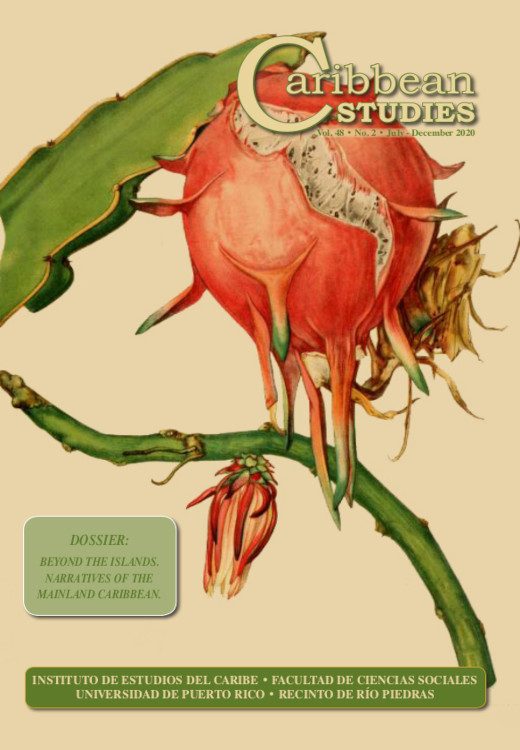Abstract
From a set of five Costa Rican photographic postcards, although a few more examples will be taken into account, an iconological task is undertaken regarding these visual relics. While the images in these cards offer an iconographic testimony, the objective is to make a visual reading of them and subject them to an iconological analysis. As a working hypothesis, considering them documentary artefacts, it is possible to select information that makes possible their contribution to historical knowledge. It is imperative to articulate the concept of “iconology” as an interpretive reading that goes far beyond the simple description of an image without strictly adhering to that which is represented. The formulation of interpretations that go beyond the boundaries of the visible is, iconographically speaking, implemented as a practice that contributes to a richer, more acute historical articulation.
References
Angulo, J.A. 1966. “Informe sobre el Valle de Matina, Moín, Costa Atlántica, Talamanca.” Revista de los Archivos Nacionales 30(1/12):217-243.
Berger, J., and J. Mohr. 1995. Another Way of Telling. New York: Vintage Books.
Berumen, M.Á. 2016. “¿Quién es el protagonista?” Alquimia 57:48-49.
Burke, P. 2001. Visto y no visto. El uso de la imagen como documento histórico. Barcelona: Crítica.
Camacho Navarro, E. 2015. Cómo se pensó Costa Rica. Imágenes e imaginarios en tarjetas postales, 1900-1930. México: CIALC-UNAM. 2017. “D.D. Gomes Casseres: acercamiento biográfico a un colombiano transnacional.” Memorias: Revista Digital de Arqueología e Historia desde el
Caribe 33:35-61.
Canepa Koch, G., and I. Kummels, eds. 2016. Photography in Latin America. Images and identities across the time and space. Bielefeld: Transcript.
Castro Harrigan, Á., and C. Castro Harrigan. 2005. Costa Rica: Imágenes e historia. Fotografías y postales, 1870-1940, volumen I. San José: Editorial Técnica Comercial. 2006. Costa Rica: Imágenes e historia. Fotografías y postales, 1870-1940, volumen II. San José: Editorial Técnica Comercial.
Castro Harrigan, Á., and Z. Sánchez Fuentes. 2012. Costa Rica: Imágenes ehistoria. Fotografías y postales, 1870-1940, volumen III. San José: Editorial Técnica Comercial.
Cooper, E. 1896. Informe sobre el camino a Matina y la costa del Norte. San José: Tipografía Nacional.
Coto Conde, J.L. 1967. “Comunicaciones al Ministro General relativas a lacomposición del camino a Matina, año de 1829.” Revista de los Archivos Nacional 31(1/12):170-177.
Cuadriello, J. 2004. Las glorias de la República de Tlaxcala o la conciencia como imagen sublime. Mexico: Instituto de Investigaciones Estéticas-UNAM.
De Sá Machado Júnior, C. 2012. Fotografías e códigos culturais. Representações da sociabilidade carioca pelas imagens da revista Careta. Porto Alegre: Evangraf.
Evans, E.J., and J. Richards. 1980. A Social History of Britain in Postcards 1870-1930. London and New York: Longman.
Fernández-Carrión, M.H. 2016. “Incidencia del pensamiento complejo y la transdisciplinariedad ante el cambio educativo en la sociedad global,” in M.R.
Guerra González, coord. Educación, complejidad y transdisciplinariedad. Mexico: Editorial Torres Asociados, 5-58.
Fontcuberta, J. 2002. El beso de Judas. Fotografía y verdad. Barcelona: Gustavo Gili.
Fraser Giffords, G., coord. 1999. “La tarjeta postal”. Artes de México, N° 48. Mexico: Artes de México.
Geary, C.M., and V-L. Webb, eds. 1998. Delivering Views: Distant Cultures in Early Postcards. Washington: Smithsonian Institution Scholarly Press.
González Flores, L. 2007. Fotografías que cuentan historias. Mexico: Instituto Nacional de Antropología e Historia-LUMEN.
Grant, S. 1999. Postales salvadoreñas del ayer/Early Salvadoran Postcards 1900- 1950. El Salvador: Banco Cuscatlán.
Guerra González, M.R. 2016. “Introducción,” in M.R. Guerra González, coord.
Educación, complejidad y transdisciplinariedad. Mexico: Editorial Torres Asociados. 2016. “La educación superior hacia un conocimiento transdisciplinar,” in M.R. Guerra González, coord. Educación, complejidad y transdisciplinariedad. Mexico: Editorial Torres Asociados, 59-85.
Photographic Postcards of the Province of Limón... 71
Levine, R. 1989. Images of History: Nineteenth and Early Twentieth Century Latin American photographs as Documents. Durham: Duke University Press.
Malagón, B. 2016. “Tras la pista útil.” Alquimia 57:35.
Massé, P. 2016. “Niñas que juegan.” Alquimia 57:26.
Montellano Ballesteros, F. 1998. Charles B. Waite. La época de oro de las postales en México. Mexico: Consejo Nacional para la Cultura y las Artes.
Mraz, J., and A.M. Mauad. 2015. Fotografía e historia en América Latina. Montevideo: Centro de Fotografía de Montevideo.
Onken, H. 2014. “Visiones y visualizaciones: La nación en tarjetas postales sudamericanas a fines del siglo XIX y comienzos del siglo XX.” Iberoamericana 56:47-69.
Panofsky, E. 2002. Estudios sobre iconología. Madrid: Alianza Editorial. 2004. El significado de las artes visuales. Madrid: Alianza Forma.
Pérez Montfort, R. 2011. “Postales de las Antillas. Estereotipos y negros en la imagen comercial del Caribe, 1900-1950,” in R. Pérez Montfort and C. Rinaudo, coords. Circulaciones culturales. Lo afrocaribeño entre Cartagena, Veracruz y La Habana. Mexico: CIESAS, 115-146.
Pérez Vejo, T. 2006. “Imágenes e historia social: una reflexión teórica,” in E. Camacho Navarro, coord. El rebelde contemporáneo en el Circuncaribe.
Imágenes y representaciones. Mexico: UNAM, 65-82.
Pretelin, C. 2016. “Vida cotidiana en una hacienda de México.” Alquimia 57:30-31.
Ripert, A., and C. Frére. 1983. La carte postale: son histoire, sa function sociale.
Lyon and Paris: University Presses of Lyon-Editions of CNRS.
Roberts, A. 2008. Postcards from The Russian Revolution. Oxford: Bodleian Library-University of Oxford. 2009. Postcards from Utopia. The Art of Political Propaganda. Oxford: Bodleian Library-University of Oxford.
Sontag, S. 2004. Ante el dolor de los demás. Mexico: Alfaguara.
Semmerling, T.J. 2004. Israeli and Palestinian Postcards, Presentation of National Self. Austin: University of Texas Press.
Stevens, N.D. 1995. Postcards in the Library: Invaluable Visual Resources. New York and London: The Haworth Press.
Stewart, W. 1967. Keith y Costa Rica. San José: Editorial Costa Rica.
Vargas, S., I. Alvarado and E. Hernández. 2004. La mirada del tiempo. Historia de la fotografía en Costa Rica, 1848-2003. San José: Fundación Museos Banco Central de Costa Rica.
Viaje del Gobernador Carrandi Manen al valle de Matina. 1738. San José: Imprenta Nacional.

